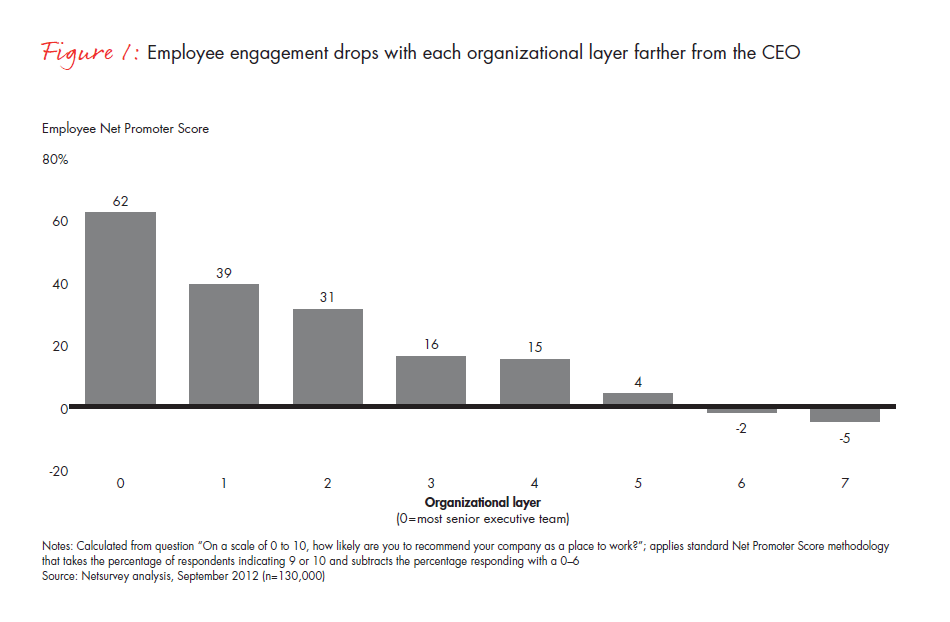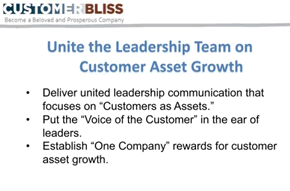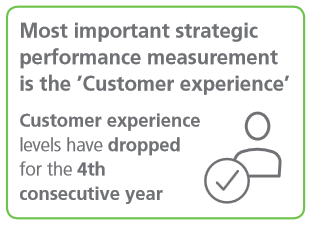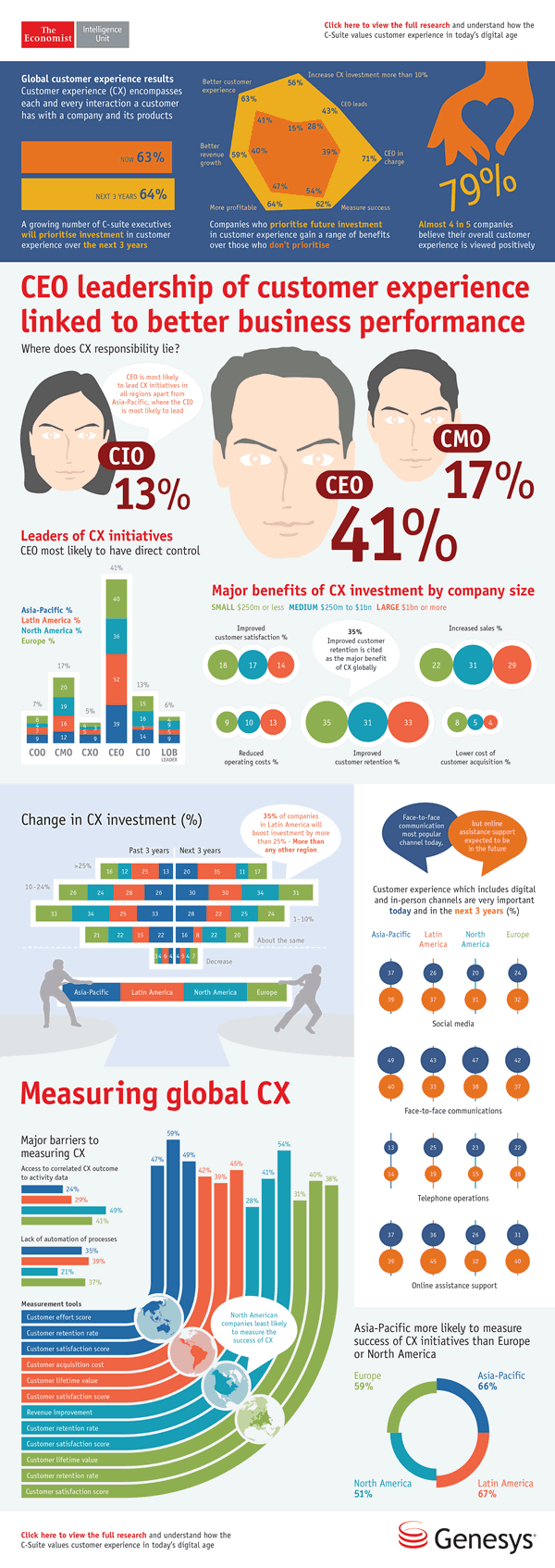Executive leadership and boardroom buy-in is essential for customer experience excellence.

Do you have someone in your company who is responsible for the improvement of customer experience, customer service and a clear, strategic and overall customer-centric optimization focus? Someone who makes sure that customer experience excellence is achieved in an enterprise-wide way?
The majority of organizations doesn’t. Given the key role of the customer in (today’s) business and the really many evolutions which led to the need of an utter focus on the customer, that’s more than a pity.
Ownership, responsibility and leadership in customer focus
Common sense says that anything that’s crucial for (future) business success requires measurable and clear responsibility (which is not the same as ownership).
Common sense also dictates that anything requiring cross-divisional and enterprise-wide focus, beyond silos, also requires – at the very least – responsibility.
The reason we make a difference between responsibility and ownership is that ownership often leads to debates that don’t really focus on the improvement of the focus or desired outcome. With responsibility comes accountability and attention for that desired outcome.
Another aspect is leadership. As change and collaboration across the organization is seldom spontaneous or natural, leadership makes sure those who are responsible work with the various stakeholders and are not stopped by internal challenges in several areas such as the human dimension, processes, organizational issues, etc.
Let’s also not forget the undeniable link between employee experience and engagement on one hand and customer experience on the other. It’s clear that employee engagement is not something that just “happens”. Bain & company found that employee engagement drops with each organizational layer farther from the CEO.

With anything that relates to the customer (end-to-end customer experience, customer engagement, customer service, marketing, employee engagement, the processes driving customer experience in the back office etc.) being essential for the business, you need leadership and responsibility over it all.
The customer needs to enter the boardroom as do customer experience excellence and customer service optimization for that matter. Ownership then becomes ownership and responsibility over various pieces of the bigger puzzle to achieve the overarching goal of improving customer-facing functions and tying these improvements to better business results as defined in the bigger plan.
Is the Chief Customer Officer a Customer Experience Excellence Officer?
De facto we see that responsibility and leadership over the customer-centric equation has been on the rise. Think about the Chief Customer Officer, for instance, a role we’ve seen growing since several years now.
The Chief Customer Officer, as Jeanne Bliss who recently published her latest book Chief Customer Experience 2.0 puts it, needs “to work with the leadership team in building the consistent behaviors, decision-making, and company engagement that will prove to the organization that leaders are united in their commitment to earn the right to customer-driven growth”. And customer-driven growth is obviously achieved by customer experience excellence.
However, despite the clear growth of the role of the Chief Customer Officer (CCO), Jeanne Bliss also reminds that “organizations still rely primarily on areas of expertise or silos to run the business”. And that has consequences. silos are deeply rooted in our organizations and customers feel it.

The question that arises is whether a CCO is enough to ‘honor and manage customers as assets”. Because that’s what they are: key assets that deserve at least as much attention as other company assets, especially as you don’t own them as you own other assets such as your office furniture or computers. Moreover, your customers are only one click away from your competitor and one bad experience from not being a customer anymore. They are highly autonomous and know what they want. The can leave at any time, even if you treat them well. That’s something office furniture won’t do.
Why customer experience needs to enter the boardroom
The valuation of customer experience, customer service, customer engagement etc. by C-level executives, the CEO and even the board becomes more important than ever.
In that sense it was rather saddening to see that, according to research by The Institute of Customer Service, “only 51% of employees and LOB managers think their CEO and Board are interested in customer insight and that less than 50% believe senior executives understand customer needs”.
There are several strong cases to make customer experience a top priority in the executive suite and enter it into the boardroom.

Customer service excellence is gauged by customer experience excellence
If we look at the key strategic performance measurement in customer service and the contact center, according to Dimension Data’s Global Contact Centre Benchmarking 2015, we see that it’s customer experience (and, ouch, levels keep dropping…).
Customer experience as key driver of retention and customer loyalty
When we identify the core drivers of customer retention and customer loyalty, two key priorities for business and the latter essential for acquisition, even if loyalty is on the decline, we again see customer experience popping up.
The ROI of customer experience excellence
In the 2015 edition of its annual Customer Experience ROI study (PDF opens), Watermark Consulting found that customer experience leaders have:
- Higher revenues due to, among others, better customer retention. Other reasons for these higher revenues (again, because of being customer experience leaders) include less price sensitivity, greater wallet share and positive word-of-mouth).
- Lower expenses due to, among others less intense service requirements of loyal customers. Other factors: less complaints and lower acquisition costs (we know the link between loyalty and acquisition but also of customer experience leadership on acquisition – make it frictionless).
In all honesty, we don’t really need surveys to understand the impact of customer experience on retention and loyalty. Customer emotions and the end-to-end customer experience (a highly emotional given as well) are known to impact both.
Customer engagement: (inter)action driven by experience
And then there is customer engagement, whereby (inter)action and tangible involvement are sought between customer/consumer and business/brand. And what is a key contributing factor to successful engagement? Indeed: customer experience, the one (emotional) thing you don’t own but can ‘design for).
In other words: customer experience is paramount in all these customer-oriented activities and functions: it shapes them and at the same time is influenced by them.
The value of customer experience is higher when CEO leadership is involved
Not convinced yet? Here is another case to bring customer experience into the boardroom.
Research, conducted by the Economist Intelligence Unit Research for customer experience and contact center solution provider Genesys has shown that CEO leadership of customer experience is linked to better business performance.
According to the research, “Value of Experience: How the C-suite values customer experience in the digital age”, companies – and thus C-level execs ) that prioritize customer experience investment show higher revenue growth (59% versus 40%) and are more profitable (64% versus 47%!) than companies where this is not the case.
The research also found that a growing number of C-suite execs will, or at least intend, to prioritize investment in customer experience over the next 3 years and that 63% of execs who make customer experience a priority effectively ‘provide’ better customer experience than others. Focus and strategic alignment across the enterprise and its ecosystem with a clear choice, message and action plan do matter indeed.

Wrapping up: leadership needs to care about customer experience now
Looking at the rest of the research, everything we mentioned in this article and the many other pieces on declining customer loyalty, changing customer behavior, the expectations of today’s customer, the competitive benefits of customer-focused organizations in a challenging global economy with ample challenges regarding costs, differentiation, process optimization and – shall we go on – it’s probably safe to say that CEOs and C-suite executives need to act now.
Those who don’t make sure that customer experience and all the other mentioned areas (customer service etc.) become strategic priorities with clear leadership and responsibilities will have another responsibility to bear. Explaining why they messed up by not creating trust, be more transparent to their customers and putting the customer and their perceptions and expectations first.
In fact, as we write this, a few CEOs of large organizations are going through exactly that: facing responsibilities they rather wouldn’t have to.
Dimension Data’s 2015 Global Contact Centre Benchmarking Report, © Dimension Data 2009-2015.
Top image purchased under license from Shutterstock

